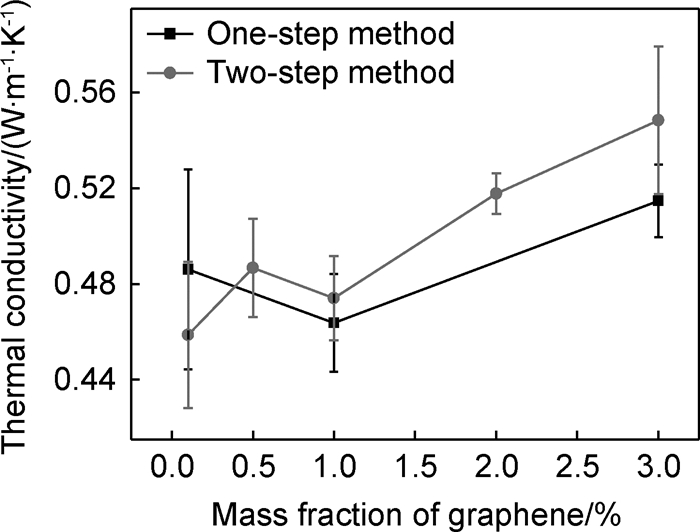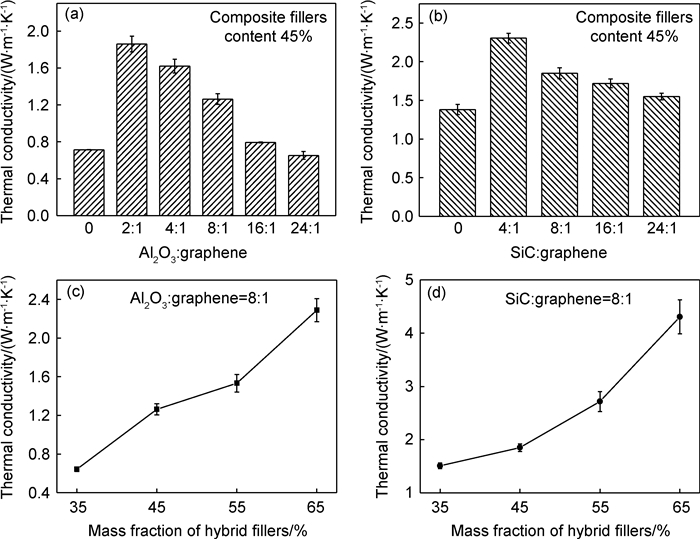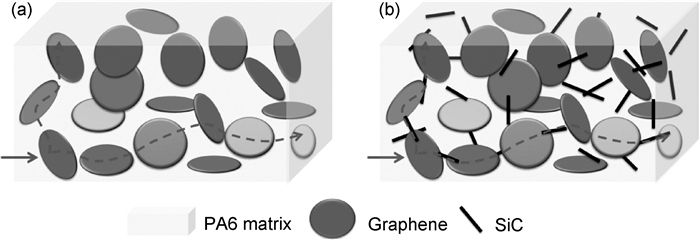文章信息
- 宋娜, 崔思奇, 焦德金, 侯兴双, 刘建影, 丁鹏, 施利毅
- SONG Na, CUI Si-qi, JIAO De-jin, HOU Xing-shuang, LIU Jian-ying, DING Peng, SHI Li-yi
- 不同填料复配对尼龙6/石墨烯复合材料导热性能的影响
- Influence of Hybrid Fillers on Thermal Conductivity of Nylon-6/Graphene Composites
- 材料工程, 2018, 46(3): 28-33
- Journal of Materials Engineering, 2018, 46(3): 28-33.
- http://dx.doi.org/10.11868/j.issn.1001-4381.2016.000904
-
文章历史
- 收稿日期: 2016-07-22
- 修订日期: 2017-10-26
2. 上海大学 机电工程与自动化学院中瑞系统集成技术中心, 上海 200444
2. SMIT Center, School of Mechanical Engineering and Automation, Shanghai University, Shanghai 200444, China
近年来,电子产品逐渐向着轻、薄、小的方向发展,同时高速的工作频率产生的热量也迅速增加,有效的散热成为电子产品能够正常运行的关键[1-3]。高分子复合材料以其低密度、易加工、耐化学腐蚀、力学性能良好等特性成为解决这一问题的理想选择。但是,目前高分子材料的导热性能并不理想,这使它的应用受到了限制,而在高分子中添加具有高导热系数的填料成为提高其导热性能的一个重要手段[4]。常用的导热填料有石墨[5]、Al2O3[6]、SiC[7]、碳纤维[8]、碳纳米管[9]等。石墨烯自被发现以来,以其优良的光学、电学等特性吸引了众多研究者的目光,而其超高的导热系数(≈5300W·m-1·K-1)也使它成为高分子复合材料中导热填料的理想选择。如今已有不少有关石墨烯在高分子复合材料中应用以提升导热系数的研究和报道[10-14]。Park等[13]通过在聚苯乙烯(PS)中加入体积分数为10%的石墨烯,将材料的导热系数提高了90%。单纯添加石墨烯来提升高分子材料的导热性能并没有取得十分理想的结果,而采用石墨烯与其他导热填料复配的方式则可在高分子导热性能提高的基础上实现成本可控[15-16]。本课题组在将石墨烯用于改善高分子材料的导热性能方面取得了一定的进展[17-21],主要包括石墨烯与氮化硼复配、石墨烯表面的共价接枝、聚酰胺在石墨烯表面的原位聚合以及石墨烯的取向排列等因素对高分子复合材料导热性能的影响。对于填充型导热复合材料来说,选择不同形状、尺寸的填料进行混合填充,能够在最大程度上形成导热通路,从而提高复合材料的导热性能[22]。
尼龙6(PA6)以其较高的机械强度、优良的抗冲击性能成为一种用量较大的工程塑料,本工作通过两步法制备了PA6/石墨烯复合材料,并通过分别将Al2O3和SiC两种常用的导热填料以不同比例与石墨烯进行复配得到复合填料,探究了复合填料的种类、配比及添加量对复合材料导热性能的影响。
1 实验材料与方法 1.1 原材料PA6切片,牌号BL2280,密度1.128g/cm3;石墨烯(G), 牌号N006-P;氧化铝(Al2O3), 型号BAK-0200,片状,平均粒径5μm;碳化硅(SiC), 平均粒径2.5μm, 长径比20。
1.2 PA6/石墨烯导热复合材料样品制备PA6切片于使用前在烘箱中90℃干燥2h。按石墨烯添加量为10%(质量分数,下同)的配方,将石墨烯与PA6加入XSS-300转矩流变仪中, 在230℃下以45r/min的转速熔融共混5min;然后经平行双螺杆挤装置挤出,剪切机剪切后得到石墨烯10%的母粒。将石墨烯母粒与PA6以石墨烯质量分数0.1%,0.5%,1%,2%和3%的配方比例加于转矩流变仪中,在230℃下以45r/min的转速熔融共混5min,制备得到相应含量的两步法制备的石墨烯/PA6复合材料。将石墨烯(质量分数分别为0.1%,1%和3%)直接与PA6置于转矩流变仪中,以相同的加工条件制备得到相应含量的一步法制备的石墨烯/PA6复合材料。
1.3 PA6/石墨烯复配导热复合材料样品制备石墨烯分别与Al2O3和SiC以一定质量比的配方比例,总填充量为45%,与PA6在相同的加工条件下熔融共混制备得到相应的不同填料配比的复合材料。Al2O3和SiC分别与石墨烯以质量比为8: 1的配方比例,在总填充量为35%,45%,55%和65%的情况下,与PA6以相同的加工条件制备得到相应的不同填料量复合材料。
1.4 复合材料导热性能测试样品的制备将复合材料粉碎后放入直径为10mm、厚度为2mm的圆形模具中,放入平板硫化机上220℃加热10min使材料软化,排气3次;以15MPa的压力于220℃下热压10min;15MPa的压力下冷却;脱模。得到直径10mm、厚度2mm的圆柱形导热性能测试样品。
1.5 性能测试与表征采用JSM-6700F型发射扫描电子显微镜(SEM)和200CX型透射电子显微镜(TEM)观测石墨烯形貌;采用Mastersizer 3000激光粒度分析仪表征石墨烯的粒度分布;采用JSM-6700F型发射扫描电子显微镜观测石墨烯在复合材料中的分布;采用INVIA共焦显微拉曼光谱仪(Raman)表征石墨烯的结构缺陷;采用AVATA370傅里叶红外光谱仪(FTIR)表征石墨烯上的官能团;采用NETZSCH激光导热仪检测复合材料的导热性能。
2 结果与分析 2.1 石墨烯的表征图 1(a), (b)分别为石墨烯的SEM和TEM图。由图中可以看出该石墨烯的表面平整,有明显层状结构,可知其为少层(少于6层)的石墨烯。由图 1 (c)的粒度分布图可知该石墨烯的尺寸呈均一分布,约为10μm。由图 1 (d)的拉曼图谱可以看出,样品在1350cm-1和1581cm-1处有两个显著的拉曼峰,分别归属于D带和G带。D带反映石墨烯片层中的无定形碳及晶格缺陷。G带是由六方石墨结构中声子E2g振动模式引起的,是碳的sp2振动特征峰[23]。D带和G带的强度比(ID/IG)可以用来衡量石墨烯的尺寸大小和结构缺陷,比值越低,说明碳无序结构和缺陷越少。本工作中所用石墨烯的ID/IG为0.19,可以认为该石墨烯拥有较少的缺陷[11]。而FTIR的结果(图 1(e))则显示该石墨烯上除羟基外并没有其他含氧官能团的存在。通过对石墨烯进行上述分析可知,该石墨烯拥有较大且均一的尺寸,较少的缺陷和含氧官能团,是高分子基体良好的导热填料。

|
图 1 石墨烯的表征 (a) SEM图像;(b)TEM图像;(c)粒径分布;(d)拉曼谱图;(e)红外谱图 Fig. 1 Characteristic of graphene (a)SEM image; (b)TEM image; (c)size distribution; (d)Raman spectrum; (e)FTIR spectrum |
图 2为不同石墨烯添加量时PA6复合材料的导热性能。从图中可以看出,通过两步法制备得到的PA6/石墨烯复合材料的导热性能由0.463W·m-1·K-1(石墨烯含量0.1%)提升到0.548W·m-1·K-1(石墨烯含量3%),与纯PA6(0.21W·m-1·K-1)相比提高了120%~161%。从图 2中还可以看出,石墨烯含量为3%时,两步法制得的复合材料的导热系数比一步法高6.5%。出现这一现象是因为两步法经过两次熔融分散过程,促进了石墨烯在复合材料中的分散。石墨烯的含量越高,越易团聚,而此时两步法提高石墨烯的分散效果越明显。虽然3%的石墨烯加入可以使PA6复合材料的导热性能提高161%,但由于PA6基体较小的导热系数,使得PA6/石墨烯复合材料的导热系数的绝对数值仍处于较低水平。在此基础上,为了进一步改善PA6复合材料的导热性能,本工作采用了将石墨烯与其他导热填料复配的方式。

|
图 2 石墨烯含量对PA6/石墨烯复合材料导热系数的影响 Fig. 2 Influence of graphene content on thermal conductivityof PA6/graphene composites |
图 3为PA6/graphene,PA6/graphene/Al2O3,PA6/graphene/SiC经液氮脆断后断面的扫描电镜照片。其中PA6/grapheme中石墨烯的含量为3%, PA6/graphene/Al2O3中复合填料量为45%,Al2O3: graphene=4: 1,PA6/graphene/SiC中复合填料量为45%,SiC: graphene=4: 1。图 3 (a)中,PA6/graphene样品相比其他样品有更加光滑的断面,且可以明显看到石墨烯在PA6基体中的层状结构[20, 24],这是由于石墨烯本身为二维层状材料,熔融共混过程保留了这一结构。在其他两个样品中(图 3(b), (c)),由于复配导热填料的添加量达45%,样品的断面变得粗糙不平。石墨烯与Al2O3, SiC之间紧密堆积、相互接触、穿插,为热量的传递提供了良好的通路,有助于复合材料导热性能的提升。

|
图 3 PA6/graphene(a), PA6/graphene/Al2O3 (b)和PA6/graphene/SiC(c)复合材料断面的扫描电镜照片 Fig. 3 Cross section SEM images of PA6/graphene (a), PA6/graphene/Al2O3 (b) and PA6/graphene/SiC(c) composites |
图 4为不同复合填料添加量及配比对PA6/石墨烯复合材料的导热性能的影响。从图 4 (a)和(b)可以看出,在复合填料量为45%的情况下,添加石墨烯的复合材料的导热系数均大于仅添加Al2O3和SiC的复合材料,且随石墨烯在复合填料中占比的增加而增加。由图 4 (a)可看出,在Al2O3和石墨烯质量比为4: 1时导热系数为1.620W·m-1·K-1,与同等填料量的PA6/Al2O3相比提高了129%,与纯PA6相比提高了671%。而从图 4 (b)中可以看出,在SiC和石墨烯质量比为4: 1时导热系数为2.305W·m-1·K-1,与同等填料量的纯PA6/SiC相比提高了66.8%,与纯PA6相比提高了781%。综上可知,当复合填料添加量固定时,石墨烯在复合填料中占比越高复合材料的导热系数越高,这是由于石墨烯本身具有较高的导热系数(≈5300W·m-1·K-1)。同时,随着石墨烯含量的提高,石墨烯片层之间以及石墨烯与Al2O3和SiC之间相互接触形成导热通路的地方较多。

|
图 4 复合填料配比(a, b)及添加量(c, d)对PA6/石墨烯复合材料导热系数的影响 Fig. 4 Influence of complex fillers ratio (a), (b) and content (c), (d) on thermal conductivity of PA6/graphene composite |
复合填料的配比为8: 1时,由图 4 (c)和(d)可以看出,复合材料的导热系数随复合填料量的增加而增加。导热系数的最大值均出现在复合填料量为65%时,PA6/graphene/Al2O3和PA6/graphene/SiC复合材料的导热系数分别为2.288, 4.307W·m-1·K-1。此时,石墨烯的含量为7.22%,复合材料的导热系数达到最佳。而在复合填料量和配比相同的条件下,添加SiC的复合材料表现出比添加Al2O3的复合材料更高的导热系数,主要是由于与Al2O3(29.3W·m-1·K-1)相比,SiC(83.6W·m-1·K-1)有相对较高的热导率。导热系数随复合填料量的增加而增加,当填料量较少时,粒子间相互接触较少,复合填料对材料的导热性能影响有限;当填料量达到一定量时,填料之间相互接触形成有效的导热网络,材料的导热性能就会大大提高。
2.2.3 SiC对复合材料导热性能的影响综合图 2及图 4可知当石墨烯的含量相近时,含有SiC的复合材料的导热性能更好。当SiC与石墨烯质量比为16: 1,总填料量为45%时,复合材料中石墨烯的含量为2.65%,其导热系数为1.720W·m-1·K-1,比图 2中石墨烯含量为3%两步法制备的复合材料高213.9%。如图 5所示,在仅添加石墨烯的复合材料中,导热通路的形成主要是通过石墨烯的排列形成,然而在低填充量下,石墨烯之间不易于相互连接形成一条较为完整的导热通路,复合材料导热系数的提高就有所限制。SiC在石墨烯间起着“桥梁”作用,可有效分散于基体和石墨烯间,与石墨烯形成更加完整的导热通路,使声子、电子在热传导运动中道路更加畅通,复合材料的导热系数提高得更明显[11, 19]。

|
图 5 PA6/石墨烯复合材料(a)和PA6/石墨烯/碳化硅复合材料(b)导热通路示意图 Fig. 5 Schematic to show the thermal conductive pathway of PA6/graphene composites(a) and PA6/graphene/SiC composites(b) |
(1) 加入3%石墨烯时,PA6复合材料的热导率为0.548W·m-1·K-1,相比纯PA6提高161%。两步法有利于PA6/石墨烯复合材料导热性能的提升。
(2) 复合材料的导热系数随复合填料量的增加而增加,随Al2O3和SiC与石墨烯质量比的降低而增加。通过调节石墨烯与Al2O3和SiC复配的比例以及复合填料量,PA6复合材料的热导率可在0.653~4.307W·m-1·K-1之间变化,相比纯PA6最高可提高1950%。为拓展石墨烯在导热材料方面的应用及PA6导热材料在工业上应用提供了有价值的实验依据。
| [1] | MONTEVERDE F, SCATTEIA L. Resistance to thermal shock and to oxidation of metal diborides-SiC ceramics for aerospace application[J]. Journal of the American Ceramic Society, 2007, 90 (4): 1130–1138. DOI: 10.1111/jace.2007.90.issue-4 |
| [2] | BALANDIN A A. Thermal properties of graphene and nanostructured carbon materials[J]. Nature Materials, 2011, 10 (8): 569–581. DOI: 10.1038/nmat3064 |
| [3] | YAN Z, LIU G, KHAN J M, et al. Graphene quilts for thermal management of high-power GaN transistors[J]. Nature Communications, 2012, 3 : 827–834. DOI: 10.1038/ncomms1828 |
| [4] | DROVAL G, FELLER J F, SALAGNAC P, et al. Rheological properties of conductive polymer composite (CPC) filled with double percolated network of carbon nanoparticles and boron nitride powder[J]. E-Polymers, 2013, 9 (1): 261–277. |
| [5] | BURGER N, LAACHACHI A, MORTAZAVI B, et al. Alignments and network of graphite fillers to improve thermal conductivity of epoxy-based composites[J]. International Journal of Heat and Mass Transfer, 2015, 89 : 505–513. DOI: 10.1016/j.ijheatmasstransfer.2015.05.065 |
| [6] |
周文英, 齐暑华, 涂春潮, 等. 导热硅橡胶复合材料研究[J].
航空材料学报, 2007, 27 (1): 33–36.
ZHOU W Y, QI S H, TU C C, et al. Thermally conductive silicone rubber composites[J]. Journal of Aeronautical Materials, 2007, 27 (1): 33–36. |
| [7] | HWANG Y, KIM J, CHO W. Thermal conductivity of thermally conductive ceramic composites and silicon carbide/epoxy composites through wetting process[J]. Polymer-Korea, 2014, 38 (6): 782–786. DOI: 10.7317/pk.2014.38.6.782 |
| [8] | KONG Q Q, LIU Z, GAO J G, et al. Hierarchical graphene-carbon fiber composite paper as a flexible lateral heat spreader[J]. Advanced Functional Materials, 2014, 24 (27): 4222–4228. DOI: 10.1002/adfm.v24.27 |
| [9] | BIERCUK M, LLAGUNO M C, RADOSAVLJEVIC M, et al. Carbon nanotube composites for thermal management[J]. Applied Physics Letters, 2002, 80 (15): 2767–2769. DOI: 10.1063/1.1469696 |
| [10] | SHI J N, GER M D, LIU Y M, et al. Improving the thermal conductivity and shape-stabilization of phase change materials using nanographite additives[J]. Carbon, 2013, 51 : 365–372. DOI: 10.1016/j.carbon.2012.08.068 |
| [11] | SHTEIN M, NADIV R, BUZAGLO M, et al. Thermally conductive graphene-polymer composites:size, percolation, and synergy effects[J]. Chemistry of Materials, 2015, 27 (6): 2100–2106. DOI: 10.1021/cm504550e |
| [12] |
李娜, 马兆昆, 陈铭, 等. 石墨烯/聚酰亚胺复合石墨纤维的结构与性能[J].
材料工程, 2017, 45 (9): 31–37.
LI N, MA Z K, CHEN M, et al. Structures and performance of graphene/polyimide composite graphite fibers[J]. Journal of Materials Engineering, 2017, 45 (9): 31–37. DOI: 10.11868/j.issn.1001-4381.2016.000251 |
| [13] | PARK W, HU J, JAUREGUI L A, et al. Electrical and thermal conductivities of reduced graphene oxide/polystyrene composites[J]. Applied Physics Letters, 2014, 104 (11): 113101. DOI: 10.1063/1.4869026 |
| [14] |
汪文, 丁宏亮, 张子宽, 等. 石墨烯微片/聚丙烯导热复合材料的制备与性能[J].
复合材料学报, 2013, 30 (6): 14–20.
WANG W, DING H L, ZHANG Z K, et al. Preparation and properties of graphene nanoplatelets/PP thermal conductive composites[J]. Acta Materiae Compositae Sinica, 2013, 30 (6): 14–20. |
| [15] | HAUSER R A, KEITH J M, KING J A, et al. Thermal conductivity models for single and multiple filler carbon/liquid crystal polymer composites[J]. Journal of Applied Polymer Science, 2008, 110 (5): 2914–2923. DOI: 10.1002/app.v110:5 |
| [16] | MA A J, LI H C, CHEN W X, et al. Improved thermal conductivity of silicon carbide/carbon fiber/epoxy resin composites[J]. Polymer-Plastics Technology and Engineering, 2013, 52 (3): 295–299. |
| [17] | DING P, SU S, SONG N, et al. Highly thermal conductive composites with polyamide-6 covalently-grafted graphene by an in situ polymerization and thermal reduction process[J]. Carbon, 2014, 66 : 576–584. DOI: 10.1016/j.carbon.2013.09.041 |
| [18] | DING P, ZHUANG N, CUI X, et al. Enhanced thermal conductive property of polyamide composites by low mass fraction of covalently grafted graphene nanoribbons[J]. Journal of Materials Chemistry C, 2015, 3 (42): 10990–10997. DOI: 10.1039/C5TC02292D |
| [19] | CUI X, DING P, ZHUANG N, et al. Thermal conductive and mechanical properties of polymeric composites based on solution-exfoliated boron nitride and graphene nanosheets:a morphology-promoted synergistic effect[J]. ACS Applied Materials & Interfaces, 2015, 7 (34): 19068–19075. |
| [20] | SONG N, YANG J, DING P, et al. Effect of polymer modifier chain length on thermal conductive property of polyamide 6/graphene nanocomposites[J]. Composites Part A, 2015, 73 : 232–241. DOI: 10.1016/j.compositesa.2015.03.018 |
| [21] | SONG N, JIAO D, DING P, et al. Anisotropic thermally conductive flexible films based on nanofibrillated cellulose and aligned graphene nanosheets[J]. Journal of Materials Chemistry C, 2016, 4 (2): 305–314. DOI: 10.1039/C5TC02194D |
| [22] | SEVOSTIANOV I, KACHANOV M. Connection between elastic moduli and thermal conductivities of anisotropic short fiber reinforced thermoplastics:theory and experimental verification[J]. Materials Science and Engineering:A, 2003, 360 (1/2): 339–344. |
| [23] | FERRARI A C, BASKO D M. Raman spectroscopy as a versatile tool for studying the properties of graphene[J]. Nature Nanotechnology, 2013, 8 (4): 235–246. DOI: 10.1038/nnano.2013.46 |
| [24] | SONG N, YANG J, DING P, et al. Effect of covalent-functionalized graphene oxide with polymer and reactive compatibilization on thermal properties of maleic anhydride grafted polypropylene[J]. Industrial & Engineering Chemistry Research, 2014, 53 (51): 19951–19960. |
 2018, Vol. 46
2018, Vol. 46


